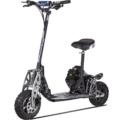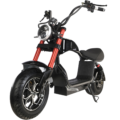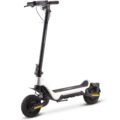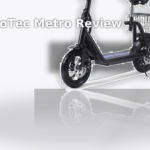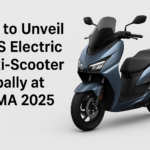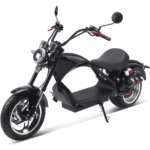- Home
- Scooters
- Electric Scooters
- MotoTec Free Ride
MotoTec Free Ride


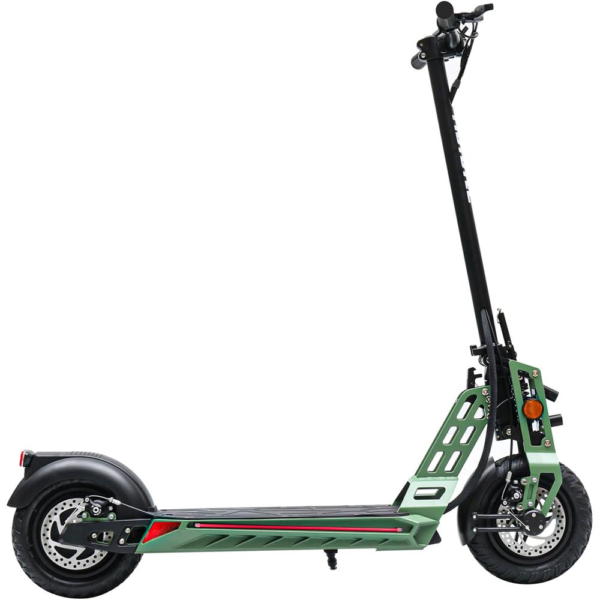
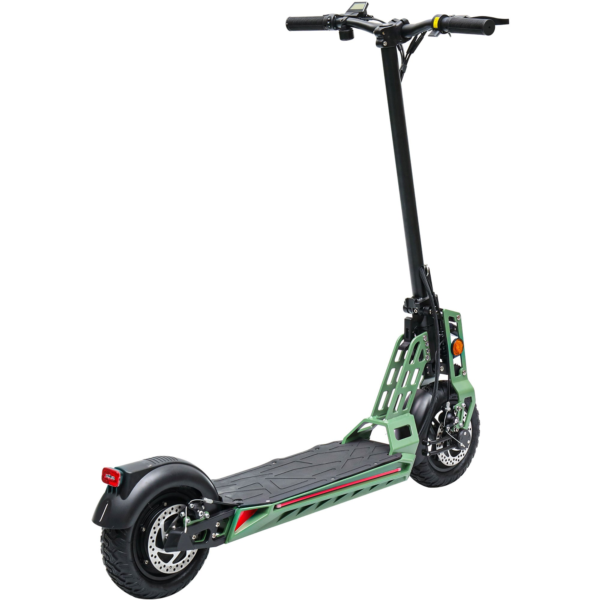
- Battery Range: 16–22 miles (25–35 km)
- Top Speed: 25 mph (40 km/h)
- Motor Power: 600 W
- Weight Capacity: 220 lb (100 kg)
- Charging Time: ~4–6 h
- Scooter Weight: Not specified
PROS
- 600W rear hub with 48V 13Ah
- 25 mph (40 km/h) top speed
- Front & rear suspension
- 10″ pneumatic tires
- Dual headlights + rear brake light + side LEDs
- LCD speed/distance display
CONS
- 16–22 mile (25–35 km) range
- Weight not specified
- No IP rating specified
Key Takeaways
- The MotoTec Free Ride is a versatile stand-up scooter with a 600-watt rear hub motor and a 48-volt lithium battery, suitable for city streets and bumpy paths.
- It features a simple cockpit, folding design, dual suspension, and bright lighting for visibility.
- With a range of 15-22 miles, the battery delivers smooth power, making it ideal for short to medium commutes.
- While it’s great for beginners and mixed routes, it’s not suited for long, steep climbs or wet conditions.
- Regular maintenance is key, including checking tire pressure, cleaning components, and ensuring safety lights function properly.
Table of contents
- What Is the MotoTec Free Ride?
- How the MotoTec Free Ride Works
- Key Specifications
- Design & Build Quality
- Performance Fundamentals
- Battery, Range & Efficiency
- Ride Quality & Comfort
- Braking & Safety Features
- Portability & Daily Usability
- Maintenance & Care
- Weather & Seasonal Considerations
- MotoTec Free Ride vs Alternatives
- Who the MotoTec Free Ride Is (and Isn’t) For
- FAQs
- Glossary
The MotoTec Free Ride is a tough, full-size stand-up scooter for city streets and bumpy side paths. It runs a 600-watt rear hub motor and a 48-volt lithium battery, so it pulls off the line clean and keeps pace on flats. It suits riders who want simple controls, real suspension, and bright lights without extra apps. And it fits new riders who like an easy display and two speed modes while they learn.
What Is the MotoTec Free Ride?
The MotoTec Free Ride is an entry-to-mid class scooter with an alloy frame, a rear hub motor, and 10-inch pneumatic tires. It folds at the neck for quick storage, and it ships with front and rear shocks that soften cracked pavement and light gravel. The cockpit is simple: thumb throttle, LCD for speed and trip, and two brake levers. You also get dual front headlights, a rear light, and side LEDs, so cars see you at dusk. And at about 48.5 lb (22 kg), it feels stable on the road yet still manageable to carry for short stretches.
How the MotoTec Free Ride Works
The system is straightforward. A brushless rear hub motor takes power from a 48-volt battery through a controller that meters current based on your thumb input. Think of the controller like a traffic cop for electrons. It smooths delivery, so the motor makes steady torque from zero, the scooter steps off cleanly, and noise stays low around town.
The battery is a 48 V, 13 Ah lithium pack in common retail trim. So you get roughly 624 Wh of usable energy for medium trips at moderate speeds. Two speed modes help new riders ease in. Start with “low” to cap peak speed, then tap “high” once you’re comfortable.
Braking is mechanical but strong. Cable-actuated discs sit at both wheels, so lever feel is firm and bite is predictable. The lighting circuit is simple too: two forward lamps for throw, a rear light for traffic behind, and LED strips along the deck sides for extra outline at night. And the LCD keeps speed and distance easy to read.
Key Specifications
All values include imperial and metric units for quick planning.
(This section uses the word “specifications” once.)
General
| Item | Value |
|---|---|
| Model | MotoTec Free Ride |
| Riding position | Stand-up, no seat |
| Recommended age | 13+ |
| Max rider weight | 220 lb (100 kg) |
Performance & Power
| Item | Value |
|---|---|
| Motor | 600 W brushless rear hub, 48 V |
| Top speed | 25+ mph (40+ km/h), two selectable modes |
| Tire size | 85/65-6.5 pneumatic, ~10 in diameter |
| Drive | Single-motor rear-wheel |
Battery, Charging & Electrical
| Item | Value |
|---|---|
| Battery | 48 V, 13 Ah lithium-ion |
| Estimated energy | ~624 Wh |
| Range | 15–22 mi (25–35 km), rider and mode dependent |
| Charge time | 4–6 hours |
| Charger port | Deck-mounted |
| Display | LCD speedometer and trip meter |
Build & Dimensions
| Item | Value |
|---|---|
| Frame | Aluminum alloy with steel rear fork |
| Suspension | Front shock and rear shock |
| Scooter size | 44.9 × 24.0 × 43.7 in (1140 × 610 × 1110 mm) |
| Folded size | 44.9 × 9.45 × 18.9 in (1140 × 240 × 480 mm) |
| Weight | 48.5 lb (22 kg) |
Safety & Control
| Item | Value |
|---|---|
| Brakes | Front disc + rear disc |
| Lights | Dual front headlights, rear light, side LEDs |
| Tires | Tubed pneumatic, max 30 PSI |
| Water | No formal IP rating; avoid wet riding |
Features & Extras
| Item | Value |
|---|---|
| Speed modes | 2 selectable levels |
| Throttle | Thumb |
| Folding | Yes, neck latch |
| Cruise control | Not provided |
Warranty & Compliance
| Item | Value |
|---|---|
| Warranty | 30-day parts replacement |
| Road use | Not for public roads in many regions; follow local rules |
Design & Build Quality
The frame mixes aluminum for the main body and steel at the rear fork for stiffness where the axle loads up. So weight stays reasonable while flex stays in check. The deck is long and flat, which helps stance options. You can ride side-by-side at low speeds or shift to a diagonal stance when pace climbs. Grip tape covers the top, and LED strips sit along the sides for visibility.
The stem folds with a neck latch that’s easy to reach. The motion is simple once you learn it, and tolerances come set well out of the box. If the hinge loosens after months of riding, a quick torque on the bolts brings it back. So the front end stays calm at cruise and doesn’t feel fussy.
The cockpit is clean. A thumb throttle sits where your right thumb rests, and the LCD sits near eye line. Digits are large, so glances stay quick. Cables run straight down the stem and tie in with zip ties. And if you add a phone mount or extra headlight, a small hook-and-loop wrap tidies any extra slack.
Fit and finish lands above toy-grade and below premium commuters. Paint holds up to light scuffs. Trim sits tight around the deck LEDs. And the hardware uses standard metric sizes, so a basic tool roll covers most jobs. Then, after about 50 miles, add a dab of medium threadlocker to the stem bolts. It keeps them from backing out.
Performance Fundamentals
Power delivery feels smooth in both modes. The motor hits hardest from 0 to about 15 mph (0 to 24 km/h), so city starts feel easy. On flat ground with a light rider, it cruises in the mid-20s without drama. But this is still a 600-watt single motor. Big hills and rough ground will ask more than it can give. Even so, the Free Ride stays predictable, and that builds confidence.
So what about hills in the 7–10% range? Short ramps are fine in high mode if you enter with a little speed. Long grades slow the scooter, and heavier riders will feel that more. Weight and wind matter. A 150-lb (68 kg) rider on smooth asphalt sees better pace than a 200-lb (91 kg) rider on coarse chip seal. So use the calm mode in crowded zones, then switch to high when space opens.
Stability improves with stance and pressure. At 25 mph (40 km/h), bend your knees and stand diagonal across the deck. The front and rear shocks take the sting out of pothole lips and expansion joints. And the tall 10-inch tires add a helpful cushion of air. On fast, choppy paths, you might feel some stem flutter. Then a firmer stance and a quick steering-bolt check calm it down.
Battery, Range & Efficiency
On paper, range lands around 15–22 miles (25–35 km). Those numbers assume level streets, a moderate pace, and a rider under 220 lb (100 kg). Real rides vary. Headwinds and hills eat energy. Cold days do too. Soft tires and stop-and-go traffic also drag the number down. And high mode burns watt-hours per mile faster, so the pack hits cutoff sooner.
You can stretch a charge with simple habits. Keep tire pressure in range. Coast toward reds to save energy. Use the lower mode in dense traffic. And try to avoid deep discharges. During storage, give the pack a recharge every 30 days. Keep the scooter dry, since moisture can corrode connectors and shorten life.
Charging is easy. The deck port sits high enough that it won’t scrape on curbs. The charger light flips from red to green when full. From near empty, plan on 4–6 hours. So if you plug in after work, you’re set for the next day. And if your weekend loop runs close to your usual range, give it a short top-up before heading out.
Ride Quality & Comfort
Tires do the first layer of work. The 85/65-6.5 pneumatics have a tall, round profile. The contact patch grows as you lean, so grip stays predictable across paint and light gravel. Then the shocks take the edge off cracks, speed tables, and broken concrete. The deck tracks straight, and the motor stays quiet, which helps on longer rides.
Hand comfort is solid for this tier. Lever throw is short, and the grips feel firm. If your palms heat up in summer, thin gloves help on long trips. Deck length fits most shoe sizes, and the flat top lets you shift for balance in turns. Then set your stance before rough patches and keep your knees soft to float over hits.
On washboard pavement at top speed, you may feel buzz in the stem. Proper pressure helps. Dropping a mph or two on choppy surfaces helps too. The hinge likes a periodic torque check, and medium threadlocker on clamp bolts keeps things tight. If lever feel goes vague, fresh pads bring the bite back.
Braking & Safety Features
The twin discs deliver steady stops with a clear bite point. Short lever travel makes feathering speed on downhills easy. So practice one or two panic stops in an empty lot and learn where the grip peaks. Pads bed in over your first rides, and rotors clean up with miles.
Lighting is above basic. Two forward lamps throw a usable beam at dusk. A rear light marks your lane position. And the deck’s side LEDs outline the scooter at cross streets. Add a helmet light for extra height if you ride at night. Then check lamp screws monthly, since vibration loosens hardware over time.
Water use is the weak spot. There’s no formal IP rating, so skip rides in rain and avoid hose washing. Puddles, slush, and road salt corrode connectors and stretch stopping distance. So ride slower on damp days and brake earlier. Wipe the scooter dry after storage in humid rooms.
Portability & Daily Usability
At 48.5 lb (22 kg), short stair carries are doable. Longer climbs feel like a workout. The folded length is 44.9 in (1140 mm), which fits most hatchbacks on a diagonal. Folded height sits under 19 in (480 mm), so it slides under many desks. The latch gives an audible snap when locked, which helps in noisy garages. And the bar width leaves space for a compact bell and a headlight bracket. If you buy online, read this short guide on Amazon Prime for electric scooter buyers. It explains shipping timing, return windows, and perks that matter for heavy boxes.
For parking, use a U-lock through the rear wheel and frame. Add a cable for the stem if the rack sits awkwardly. Bring the charger if your round trip is near your usual range. Then store the scooter indoors to protect the pack from hot attics and cold balconies.
Maintenance & Care
Daily, before you ride
- Check tire pressure and tread.
- Spin each wheel and listen for rotor rub.
- Squeeze both levers and feel for a firm bite.
Weekly
- Torque the stem hinge bolts and bar clamp.
- Wipe the deck and cables with a damp cloth.
- Inspect side LEDs and the rear light.
Monthly or every 100–150 miles
- Check pad thickness and rotor alignment.
- Re-apply threadlocker if you loosen stem hardware.
- Inspect tires for cuts and embedded glass.
Battery habits
- Charge the same day you ride.
- Don’t store empty. Keep a mid-state if you pause for weeks.
- Keep the pack at room temperature when you can.
Tire pressure
- Stay under 30 PSI. Use a gauge you trust. Recheck after a short ride and adjust for comfort and grip.
Weather & Seasonal Considerations
Cold weather lowers battery output, so range drops. Warm storage helps packs recover. Summer heat boosts grip but stresses batteries. So avoid long sun baking and let the pack cool before charging. Keep dust off charger vents, since airflow matters.
Rain riding isn’t a good idea here. Wet roads cut traction, and spray can reach connectors. If a route is damp, slow down, brake sooner, and skip puddles that can hide holes. Winter salt attacks hardware, so wipe the scooter after each ride and dry it before storage. Then add a tiny drop of oil to the latch pivot to keep the fold smooth.
MotoTec Free Ride vs Alternatives
Compared with small commuters (250–350 W): This scooter launches harder and holds speed better on mild hills. The frame feels tougher, and the suspension tames broken patches. The tradeoff is weight and folded length, since slim commuters carry easier. So if you carry long distances every day, a lighter class might fit better. If you want a slimmer city model with a classic stance, take a look at the MotoTec Metro. It trades some suspension travel for easier carries.
Compared with bigger single-motor trail models: Takeoff feels similar, and total weight may be lower here. You gain bright lights and a cockpit that beginners understand fast. You give up bigger packs and larger brakes found on heavier trail scooters. And you keep a cleaner fold that fits trunks and office nooks.
Compared with dual-motor street machines: Price and simplicity favor the Free Ride. You lose hard launches and fast climbs on steep grades. If you face long hills often, a stronger class makes sense. Then again, if you ride mixed streets and park paths at steady speeds, this model covers the basics well.
Who the MotoTec Free Ride Is (and Isn’t) For
Great for:
- Short to medium commutes on mixed pavement.
- Students and first-time riders who want steady power and simple controls.
- Multi-modal trips that mix scooting with trains or carpools.
- Suburban loops on bike lanes, neighborhood streets, and park paths.
Not ideal for:
- Long, fast routes that need high sustained speed.
- Daily steep hills above roughly 10% grade.
- Wet regions that call for an IP-rated chassis.
FAQs
1) How fast does the MotoTec Free Ride go?
It reaches the mid-20s in mph on flat ground, and two modes cap or unlock top speed.
2) What is the real-world range?
Plan on 15–22 miles (25–35 km) per charge on level routes at moderate pace. Heavier riders, hills, and headwinds lower that number.
3) Does it have cruise control?
No. The layout stays simple: thumb throttle, two levers, and a mode button.
4) Can I ride it in the rain?
Skip wet rides. There’s no IP rating here.
5) What tire pressure should I use?
Stay under 30 PSI. Set a level that balances comfort and grip for your weight.
6) What does the warranty look like?
Expect a short parts-replacement window of about 30 days.
7) Where can I find a quick MotoTec Free Ride overview?
You’re reading one now. It packs the big points—design, range, comfort, and care—into a single page.
Glossary
- Ah (amp-hour): Battery capacity. Higher numbers store more charge.
- Wh (watt-hour): Energy. Multiply voltage by amp-hours.
- Controller: The board that meters battery power to the motor.
- Hub motor: A motor built into the wheel hub.
- Torque: The twist that turns the wheel.
- Regen: Electronic braking that returns energy to the pack. Not used here.
- Stem flex: Small front-end movement from the fold neck under load.
- PSI: Tire pressure in pounds per square inch.
- IP rating: Code for dust and water protection levels.
- Rim: The metal hoop that holds the tire.
- Brake fade: Loss of stopping power as parts heat up.
- Deck: The standing platform.
- LCD: The screen that shows speed and distance.
- Speed mode: A setting that caps peak speed.
- Cutoff: The point where low voltage stops the motor.
Specifications
General
| Model The Model specifies the exact version or name of the scooter. It helps identify its unique design, features, and specifications within the manufacturer’s product line. Knowing the model makes it easier to compare options, find compatible accessories, or look up support information. | Free Ride |
| Brand The Brand identifies the manufacturer or company that designs and produces the scooter. A trusted brand is a sign of quality, reliability, and good customer support. Well-known brands often have higher standards for safety, performance, and after-sales service, giving you more confidence in your purchase. | MotoTec |
| Release Date The Release Date indicates when the scooter model was officially launched on the market. This helps you know how current the design, technology, and features are. A newer release date often means updated components, improved performance, and the latest safety or smart features. | 18 November 2025 |
| Recommended Age Recommended Age indicates the minimum age range that the scooter is designed for, based on safety, size, and ease of use. Following the recommended age helps ensure that riders can handle the scooter’s speed, weight, and controls comfortably and safely. Always check local laws and use protective gear, especially for younger riders. | 13+ |
Performance & Power
| Motor Power (Wattage) What it means: The motor power, measured in watts (W), shows how strong the scooter’s electric motor is. Why it matters: Higher wattage usually means better acceleration, more torque, and improved performance on hills or rough terrain. For example, a 250W motor is good for flat city roads and light riders, while a 500W or 1000W motor provides more power for faster speeds or climbing steep inclines. | 600 W rear hub (brushless) |
| Top Speed The Top Speed indicates the maximum speed that the scooter can reach under optimal conditions. It’s usually measured on level ground with a fully charged battery and an average rider weight. A higher top speed allows you to travel longer distances faster, but always ensure you ride within legal speed limits and your personal comfort zone for safety. | 25 mph (40 km/h) — 2 selectable speeds |
| Battery Capacity Battery Capacity refers to the total amount of energy the scooter’s battery can store, usually measured in ampere-hours (Ah) or watt-hours (Wh). A higher battery capacity means you can ride longer distances on a single charge, reducing the need for frequent recharging. Keep in mind that actual range can vary depending on rider weight, terrain, speed, and weather conditions. | 48 V 13 Ah (624 Wh) |
| Estimated Range per Charge The Estimated Range per Charge indicates the average distance the scooter can travel on a single full battery charge. This range is calculated under optimal conditions, such as flat terrain, moderate speed, and average rider weight. Real-world range may vary depending on riding style, terrain, weather, and load. A longer range means fewer recharges and greater freedom for longer trips. | 16–22 miles (25–35 km) |
| Hill Climb Ability Hill Climb Ability describes the maximum incline or slope that the scooter can handle while maintaining stable performance. It’s typically expressed as a percentage or in degrees. A higher hill climb rating means the scooter can tackle steeper hills without losing too much speed or power. Actual climbing performance may vary based on rider weight, battery charge, and terrain conditions. | Not specified |
| Drive System The Drive System refers to how power from the motor is delivered to the wheels. Electric scooters typically use either a hub motor (directly integrated into the wheel) or a chain/belt drive system. A high-quality drive system ensures smooth acceleration, efficient power transfer, and low maintenance. The choice of drive system affects performance, noise level, and overall ride experience. | Rear hub (RWD) |
Charging & Electrical
| Charging Time Charging Time indicates how long it takes to fully recharge the scooter’s battery from empty to 100% using the standard charger provided. Faster charging means less downtime and more time on the road. Actual charging time may vary slightly depending on battery capacity, charger output, and environmental conditions. | Approx. 4–6 hours |
| Battery Type Battery Type refers to the specific technology used in the scooter’s battery, which affects performance, lifespan, weight, and charging time. Most modern electric scooters use high-quality lithium-ion (Li-ion) batteries because they offer a good balance of energy density, durability, and low maintenance. A reliable battery type ensures consistent power delivery and longer riding ranges. | Lithium-ion pack |
| Removable Battery A Removable Battery means the battery pack can be easily detached from the scooter for convenient charging and replacement. This feature allows you to charge the battery separately, swap it with a spare for extended range, or securely store it indoors in extreme weather. Removable batteries add flexibility and make it easier to keep your scooter powered up wherever you are. | Non-removable internal battery (fixed pack) |
| Regenerative Braking Regenerative Braking is an energy-saving feature that converts some of the energy normally lost during braking back into battery power. When you slow down or brake, the motor works in reverse to generate electricity, which helps extend the scooter’s range and improves overall efficiency. This system also reduces wear on traditional brake components, leading to lower maintenance over time. | No |
| Lighting Lighting refers to the built-in front and rear lights that enhance visibility and safety when riding in low-light conditions or at night. Good lighting helps you see the road ahead and ensures that other road users can see you. Many scooters include LED headlights, taillights, and sometimes brake lights or side reflectors for added safety and compliance with local traffic regulations. | Dual front headlights, rear brake light, LED side strips; LCD meter |
Build & Dimensions
| Scooter Weight Scooter Weight refers to the total weight of the scooter when fully assembled, including the battery. This affects how easy it is to carry, lift, and store the scooter when not in use. A lighter scooter is more portable and convenient for commuting, especially if you need to carry it upstairs or onto public transport. Keep in mind that a sturdy frame and quality components may add to the weight but also contribute to better durability and ride stability. | Not specified |
| Maximum Rider Weight Maximum Rider Weight indicates the highest rider weight that the scooter is designed to safely support while maintaining optimal performance and stability. Staying within this limit helps ensure reliable acceleration, braking, and climbing ability, and it protects the frame, suspension, and motor from excessive strain. Exceeding the recommended limit may reduce performance and increase wear on components. | 220 lb (100 kg) |
| Deck Size Deck Size refers to the dimensions of the scooter’s standing platform. A wider and longer deck provides more foot space, allowing you to stand comfortably and adjust your stance while riding. A well-sized deck improves balance and stability, especially on longer rides or at higher speeds. Compact decks, on the other hand, help keep the scooter lightweight and portable. | Industrial-style frame; off-road capable |
| Handlebar Height Handlebar Height refers to the distance from the deck to the handlebars, which affects your riding posture and comfort. An appropriate handlebar height helps you maintain good balance, reduces strain on your back and arms, and makes steering more comfortable. Some scooters have adjustable handlebars to fit riders of different heights, while others have a fixed height for a streamlined design. | Fixed |
| Folding Mechanism The Folding Mechanism describes how easily and securely the scooter can be folded for carrying and storage. A well-designed folding system lets you quickly collapse the scooter into a compact size, making it convenient to transport on public transit, store under a desk, or fit into a car trunk. Look for sturdy latches and safety locks to ensure the scooter stays firmly in place when folded or unfolded. | Folding: Yes |
| Dimensions Folded Dimensions indicate the size of the scooter when it’s fully folded. This measurement shows how much space the scooter will take up when stored or carried, making it easier to check if it will fit in your car trunk, under a desk, or in a closet. Compact folded dimensions are ideal for commuters who need to bring their scooter on public transport or store it in tight spaces. | Dimensions: Not specified; Folded: Not specified |
| Material Material refers to the primary construction materials used for the scooter’s frame and key components. High-quality materials like aircraft-grade aluminum, reinforced steel, or durable composites provide strength, stability, and a lighter overall weight. A sturdy material ensures the scooter can handle daily wear and tear while maintaining safety and performance. | Aluminum alloy |
Safety & Control
| Brake Type(s) Brake Type(s) describe the braking systems the scooter uses to help you slow down or stop safely. Common brake types include mechanical brakes (like drum or disc brakes), electronic brakes, and foot brakes. Many scooters combine multiple braking systems for added safety and shorter stopping distances. The type and quality of brakes affect your control, especially when riding at higher speeds or on slopes. | Front & rear disc |
| Suspension Suspension refers to the system that absorbs shocks and vibrations while riding, providing a smoother and more comfortable ride over uneven or rough surfaces. Scooters may have front suspension, rear suspension, or dual suspension for better shock absorption and stability. Good suspension helps reduce rider fatigue and improves control, especially when riding on bumpy roads or off-road paths. | Front & rear suspension |
| Tire Type Tire Type refers to the kind of tires the scooter uses, which directly affects ride comfort, traction, and maintenance. Common types include solid (airless) tires, pneumatic (air-filled) tires, or hybrid options. Pneumatic tires offer better shock absorption and a smoother ride on rough surfaces, while solid tires are puncture-proof and require less upkeep. The right tire type helps ensure safe handling and a comfortable ride in different conditions. | 10″ pneumatic (85/65-6.5) |
| Tire Size Tire Size indicates the diameter and width of the scooter’s tires, which affect ride comfort, stability, and how well the scooter handles different terrains. Larger tires generally offer better shock absorption and a smoother ride over bumps and rough surfaces, while smaller tires keep the scooter lighter and more portable. Choosing the right tire size helps ensure a balance between agility and comfort. | 10-inch |
| Kickstand The Kickstand is a built-in stand that allows you to park your scooter upright when it’s not in use. A sturdy kickstand keeps the scooter stable and prevents it from tipping over, protecting it from scratches and damage. It also makes storing and accessing your scooter more convenient, whether you’re at home, work, or on the go. | Not specified |
| Water Resistance Rating Water Resistance Rating indicates how well the scooter is protected against water and moisture, usually shown as an IP (Ingress Protection) rating. This rating helps you understand whether the scooter can handle light rain, splashes, or wet roads without damage. While most scooters are not fully waterproof, a good water resistance rating adds peace of mind when riding in changing weather conditions. Always avoid deep puddles or submerging the scooter to protect its electrical components. | Not specified |
Features & Extras
| Display/Console The Display (or Console) shows important real-time information about your ride, helping you monitor your scooter’s status at a glance. Typical displays show speed, battery level, distance traveled, and riding mode. Some models also include additional features like Bluetooth connectivity, app integration, or backlighting for better visibility at night. A clear and easy-to-read display enhances safety and convenience on every trip. | LCD screen (speed, distance, battery) |
| Ride Modes Ride Modes refer to the different speed and power settings you can choose to match your riding style or road conditions. Common modes include eco for maximum range and energy efficiency, standard for everyday balance, and sport or turbo for higher speed and stronger acceleration. Switching between ride modes allows you to customize performance, conserve battery, and ride safely in various environments. | 2 speeds |
| Smart App Connectivity Smart App Connectivity lets you pair your scooter with a dedicated mobile app via Bluetooth. Using the app, you can monitor real-time ride stats like speed, battery level, and range, adjust settings such as ride modes or cruise control, lock the scooter for added security, and sometimes receive firmware updates. This feature adds convenience and allows you to personalize your riding experience right from your smartphone. | No app |
| Anti-Theft System The Anti-Theft System helps protect your scooter from unauthorized use or theft. This feature can include built-in alarms, electronic motor locks, GPS tracking, or remote locking through a mobile app. A good anti-theft system provides peace of mind when parking your scooter in public spaces, adding an extra layer of security to safeguard your investment. | Not specified |
| Cruise Control Cruise Control allows you to maintain a steady speed without continuously holding the throttle. This feature makes longer rides more comfortable by reducing hand fatigue and providing a smoother, more relaxed riding experience — especially on flat, open roads or bike lanes. For safety, cruise control can usually be easily activated or deactivated while riding. | Not specified |
| Accessories Included Accessories Included lists the additional items that come with the scooter to enhance your riding experience and convenience. Common accessories may include a charger, kickstand, bell, lights, phone holder, or carrying strap. These extras add value by making your scooter safer, easier to use, and ready to ride straight out of the box. | Scooter, charger, tools, manual |
Warranty & Compliance
| Warranty Period The Warranty Period indicates how long the manufacturer guarantees the scooter against defects in materials and workmanship under normal use. A good warranty provides peace of mind, showing the brand’s confidence in its product quality. Always check what parts are covered, such as the frame, battery, and motor, and follow the maintenance guidelines to keep your warranty valid. | 30 days parts replacement (region-dependent) |
| Certifications Certifications confirm that the scooter meets specific safety, quality, and environmental standards set by recognized organizations or regulatory bodies. Common certifications may include CE, RoHS, UL, or other local compliance marks, depending on your region. These certifications ensure that the scooter is manufactured to high standards and is safe and legal to use in your country. | Local micromobility compliance |


